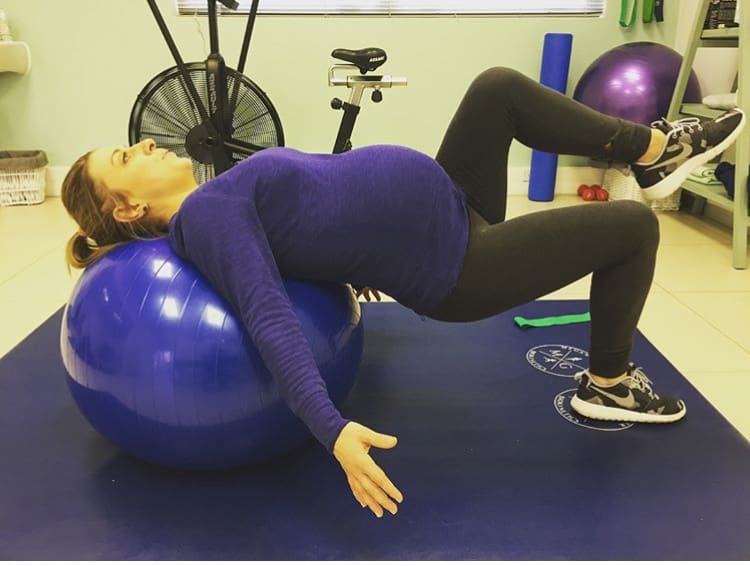Why, would you say, is it important for women to exercise regularly during pregnancy?
The most important things is for labour preparation and the recovery thereof. Important muscles to be kept strong are the pelvic floor, the deep core muscles (ie. the transverse abdominus), other secondary muscles that are important are the six pack (rectus abdominus), side muscles (obliques). Theses all play an important role during labour. During pregnancy, the pelvis undergoes extreme changes and it is vital to keep pelvic stabilising muscles, such as glutes, hip flexors and inner thighs strong. If all of the above are done, the chances of diastasis rectus happening, decreases hugely. Diastasis rectus is when the muscle fibres of the six pack muscles tear along the mid-line due to the pressure of the stretching that occurs when the baby grows. Regular exercise during pregnancy also helps to reduce the risk of developing gestational diabetes.
What are the main health benefits?
There are many hidden benefits that people don’t realise! For example: Improved blood lipid profile (cholesterol). Improved insulin sensitivity (how well your body reacts to insulin). Reduced weight gain. Having stronger and more stable muscles will help to reduce back and groin pain which are both very common during pregnancy. Exercise secretes hormones such as dopamine and serotonin (endorphins – happy hormones). There is extensive evidence that recovery time after birth – natural or caesarian – is greatly reduced if the mother has engaged in regular exercise during pregnancy.
What types of exercises are safe and recommended for pregnant women?
Usually, any exercise the pregnant lady has done before pregnancy, should be safe during pregnancy (provided there are no complications). So this isn’t the time to decide you’d like to complete a 10km run if you’ve never run before. The best combination would be some cardiovascular exercise (stationary cycling, walking or jogging, elliptical walker, swimming) combined with good strengthening exercises. Preggy Pilates classes are a great idea as they focus on the smaller, important muscles such as the pelvic floor. Prenatal yoga can help manage stress & anxiety, and stretch out any tight muscles (particularly those in the buttocks that can contribute to lower back pain). Hydrotherapy can feel amazing when the pregnancy is far along, as the water helps to support the load of the tummy. A good rule of thumb is to do 60% of what you use to do.
What exercises should be avoided and why?
Pregnant ladies should be careful of endurance activities such as: marathon running due to the risk of overheating or dehydration. Hot yoga should also be avoided for these reasons. As a rule, a pregnant lady shouldn’t exert herself more than a 7 out of 10 in terms of effort This is a subjective measure known as a Rating of Perceived Exertion (RPE), and should be kept in mind during exercise. Obviously, any exercise where there is a risk of falling, should be avoided, e.g. complicated hikes and mountain biking. After the second trimester, any lying on the back should not be done for lengthy periods of time and therefore we focus on a lot more side-lying exercises during Biokinetics and pilates sessions.
What pregnancy changes, such as the shift in your centre of gravity (or other factors), may affect exercise?
Your centre of gravity will change as your baby grows as there is more weight in-front of your body. This can definitely play a role on your balance. You will find that you need to get use to it and adjust weight distribution and stance accordingly and be-careful with regards to risk of falling. All ligaments in the body become slightly more “loose” during pregnancy, due to the secretion of the hormone relaxin. This could mean slightly less stable ankles for example. So watch out on unstable surfaces.
Can you provide short descriptions of three exercises that are safe for pregnant women to do at home?
Bridge ball squeeze
Lie on back, knees bent, arms at side, feet flat on floor.
Have your feet in line with your hips.
Place a cushion between your knees.
Lift your pelvic floor to activate your core.
Push up through your heels, using your glutes to lift your hips.
Squeeze the cushion so that you inner thighs activate.
Hold the squeeze for 3 sec.
Lower slowly and release.
Repeat (approx. 2 x 10)
–
Superman
Begin on hands and knees.
Place your hands beneath your shoulders, and your knees beneath your hips.
Imagine a tray of tea on your back.
Tighten you ‘core’ (activate pelvic floor & lift belly button)
Extend the right leg while lifting the left arm.
Hold 2-3 seconds.
Return to start position and repeat with left leg and right arm.
Sit to stand
Sit on a chair toward the front.
Place heels under knees, and have knees bent to 90 degrees.
Engage pelvic floor as you lean forward.
Push into heels, squeeze glutes and stand
Sit down slowly.
Repeat.
NB don’t allow knees to drop inward during this.

